18 june 2018
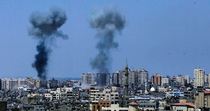
An Israeli drone on Monday evening bombed a resistance site in al-Qarara town east of Khan Younis city in the southern Gaza Strip.
The PIC reporter said that an Israeli reconnaissance plane bombed with 3 missiles a small room and another target in the town.
He added that the site belongs to al-Qassam Brigades, the armed wing of Hamas Movement.
There were no reports of human casualties in spite of the great damage that resulted from the Israeli airstrike.
The PIC reporter said that an Israeli reconnaissance plane bombed with 3 missiles a small room and another target in the town.
He added that the site belongs to al-Qassam Brigades, the armed wing of Hamas Movement.
There were no reports of human casualties in spite of the great damage that resulted from the Israeli airstrike.
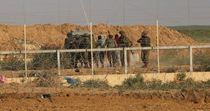
Five Palestinian youths were injured on Thursday afternoon during an alleged attempt to damage what the Israeli army called security infrastructure near the Gaza border, Israeli sources claimed.
Israeli army said in a statement that five Palestinians were injured at the border fence after they allegedly “tried to sabotage security infrastructure in the area near the barrier north of Gaza Strip.
The security infrastructure exploded and as a result.”
The Palestinian Health Ministry earlier said 24-year-old Sabri Abu Khader was killed after being shot by Israeli gunfire near the border fence.
The IOF soldiers at the border on a daily basis attack the Palestinians protesting peacefully in the Great March of Return along the borderline with live ammunition and explosive bullets.
Israeli army said in a statement that five Palestinians were injured at the border fence after they allegedly “tried to sabotage security infrastructure in the area near the barrier north of Gaza Strip.
The security infrastructure exploded and as a result.”
The Palestinian Health Ministry earlier said 24-year-old Sabri Abu Khader was killed after being shot by Israeli gunfire near the border fence.
The IOF soldiers at the border on a daily basis attack the Palestinians protesting peacefully in the Great March of Return along the borderline with live ammunition and explosive bullets.

Israeli warplanes at dawn Monday launched airstrikes on three resistance sites in the Gaza Strip.
The PIC reporter said that at least 9 missiles were fired at three different sites in Gaza. The bombing, which coincided with dawn prayer, caused severe damages in the targeted sites and their surroundings.
Local sources said that rockets were fired from the Gaza Strip by Palestinian resistance factions in response to the Israeli attacks. Sirens were reportedly heard in Israeli settlements adjacent to the coastal enclave.
Israeli drones on Sunday fired a missile at a group of Palestinian youths who were flying fire kites and balloons toward Israeli settlements near the Gaza border.
Another airstrike was launched on a Palestinian resistance site east of al-Bureij refugee camp in the central Gaza Strip with no casualties reported.
These Israeli attacks are a new violation of the ceasefire agreement between Israel and the resistance factions which was reactivated in May under Egyptian auspices.
The PIC reporter said that at least 9 missiles were fired at three different sites in Gaza. The bombing, which coincided with dawn prayer, caused severe damages in the targeted sites and their surroundings.
Local sources said that rockets were fired from the Gaza Strip by Palestinian resistance factions in response to the Israeli attacks. Sirens were reportedly heard in Israeli settlements adjacent to the coastal enclave.
Israeli drones on Sunday fired a missile at a group of Palestinian youths who were flying fire kites and balloons toward Israeli settlements near the Gaza border.
Another airstrike was launched on a Palestinian resistance site east of al-Bureij refugee camp in the central Gaza Strip with no casualties reported.
These Israeli attacks are a new violation of the ceasefire agreement between Israel and the resistance factions which was reactivated in May under Egyptian auspices.

Sabri Ahmad Abu Khader, 24
Israeli soldiers shot, on Monday at noon, a young Palestinian man near the Great Return Camp, east of Gaza city, causing a serious injury.
Medical sources in Gaza said the Palestinian was rushed to the Shifa Medical Center, in Gaza city, before he was admitted to surgery, after suffering severe wounds.
The young man, identified as Sabri Ahmad Abu Khader, 24, was shot after the soldiers fired live rounds targeting protesters, east of Gaza city. video
ٍٍSabri was a newlywed young man, who got married only five months ago. He was shot near Karni Crossing, east of Gaza city.
Israeli sources said some protesters continued to launch burning kites across the border fence, causing a new fire near Kissufim military base, in southern Gaza.
In related news, the Israeli army claimed that its soldiers observed two Palestinians, “who tried to breach the border fence,” and added that they carried explosives, which detonated while they were running back to Gaza, apparently wounding them.
Israeli soldiers shot, on Monday at noon, a young Palestinian man near the Great Return Camp, east of Gaza city, causing a serious injury.
Medical sources in Gaza said the Palestinian was rushed to the Shifa Medical Center, in Gaza city, before he was admitted to surgery, after suffering severe wounds.
The young man, identified as Sabri Ahmad Abu Khader, 24, was shot after the soldiers fired live rounds targeting protesters, east of Gaza city. video
ٍٍSabri was a newlywed young man, who got married only five months ago. He was shot near Karni Crossing, east of Gaza city.
Israeli sources said some protesters continued to launch burning kites across the border fence, causing a new fire near Kissufim military base, in southern Gaza.
In related news, the Israeli army claimed that its soldiers observed two Palestinians, “who tried to breach the border fence,” and added that they carried explosives, which detonated while they were running back to Gaza, apparently wounding them.
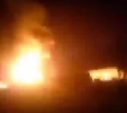
The Israeli Air Force fired, on Monday at dawn, several missiles into sites, believed to be run by the al-Qassam Brigades, the armed wing of Hamas movement in the Gaza Strip, causing damage.
The first strike targeted the “Bader” center, and the second strike targeted the Safina site, west of Gaza city; both were struck with around three missiles each. video
Media sources in Gaza said the sounds and impacts of the explosion could be heard and felt across the entire area and led to property damage.
Meanwhile, Israeli sources said Palestinian fighters reportedly fired three shells from Gaza and landed in open areas.
The Israeli escalation is the fourth against the coastal region in 24 hours, after the army fired missiles at what it called “Palestinians launching burning balloons,” while sources in Gaza said another site of al-Qassam Brigades was targeted, east of the al-Boreij refugee camp, in central Gaza.
On Sunday at dawn, an Israeli military drone fired a missile at a Palestinian car which was parked near a mosque, east of Gaza City.
On Saturday evening, two Palestinians were injured after an Israeli military drone fired a missile at Palestinians allegedly flying burning kites in central Gaza.
The Israeli military, its government and affiliated “media” outlets, have been reporting on the “incendiary kites,” as the cause for the ongoing escalation in Gaza.
They even engaged in smear campaigns against Palestinians slain by Israeli snipers, including the medic, Razan Najjar, by alleging she was a “human shield for Hamas.”
In an interview shortly before Razan was murdered by an Israeli sniper, she said what she does as a medic, the help that she gives to wounded Palestinians is meant to help the people and ease their suffering, and added that the “medics are the shield of the people.”
The statement, as simple and clear it was, was abused and misused to justify her murder by an army sniper, stationed safely hundreds of meters away.
She was the second medic to be killed by the army since March 30th, 2018, after the soldiers killed, Mousa Jaber Abu Hassanein, 36.
The army also injured 223 medics, and caused damage to 37 ambulances.
In addition, the soldiers killed two journalists, identified as Yasser Mortaja, 31, and Ahmad Abu Hussein, 25, and wounded 144 others.
On June 14th, a Palestinian identified as Ahmad Ziad Tawfiq al-‘Aassi, 21, died of wounds inflicted several days earlier by an Israeli gas bomb which struck him directly in his head, causing very serious wounds.
His death brings the number of Palestinians, who were killed by Israeli army fire since March 30th, to 126, including two journalists and thirteen children
The army also injured 13672 others, including hundreds of suffered serious wounds, mainly after being shot with expanding bullets.
The first strike targeted the “Bader” center, and the second strike targeted the Safina site, west of Gaza city; both were struck with around three missiles each. video
Media sources in Gaza said the sounds and impacts of the explosion could be heard and felt across the entire area and led to property damage.
Meanwhile, Israeli sources said Palestinian fighters reportedly fired three shells from Gaza and landed in open areas.
The Israeli escalation is the fourth against the coastal region in 24 hours, after the army fired missiles at what it called “Palestinians launching burning balloons,” while sources in Gaza said another site of al-Qassam Brigades was targeted, east of the al-Boreij refugee camp, in central Gaza.
On Sunday at dawn, an Israeli military drone fired a missile at a Palestinian car which was parked near a mosque, east of Gaza City.
On Saturday evening, two Palestinians were injured after an Israeli military drone fired a missile at Palestinians allegedly flying burning kites in central Gaza.
The Israeli military, its government and affiliated “media” outlets, have been reporting on the “incendiary kites,” as the cause for the ongoing escalation in Gaza.
They even engaged in smear campaigns against Palestinians slain by Israeli snipers, including the medic, Razan Najjar, by alleging she was a “human shield for Hamas.”
In an interview shortly before Razan was murdered by an Israeli sniper, she said what she does as a medic, the help that she gives to wounded Palestinians is meant to help the people and ease their suffering, and added that the “medics are the shield of the people.”
The statement, as simple and clear it was, was abused and misused to justify her murder by an army sniper, stationed safely hundreds of meters away.
She was the second medic to be killed by the army since March 30th, 2018, after the soldiers killed, Mousa Jaber Abu Hassanein, 36.
The army also injured 223 medics, and caused damage to 37 ambulances.
In addition, the soldiers killed two journalists, identified as Yasser Mortaja, 31, and Ahmad Abu Hussein, 25, and wounded 144 others.
On June 14th, a Palestinian identified as Ahmad Ziad Tawfiq al-‘Aassi, 21, died of wounds inflicted several days earlier by an Israeli gas bomb which struck him directly in his head, causing very serious wounds.
His death brings the number of Palestinians, who were killed by Israeli army fire since March 30th, to 126, including two journalists and thirteen children
The army also injured 13672 others, including hundreds of suffered serious wounds, mainly after being shot with expanding bullets.
17 june 2018

By Ramona Wadi
The latest Human Rights Watch (HRW) report titled “Israel: Apparent War Crimes in Gaza” commences with a sentence that mars the rest of its investigation and analysis. “Israeli forces’ repeated use of lethal force in the Gaza Strip since March 30 2018, against Palestinian demonstrators who posed no imminent threat to life may amount to war crimes.”
Juxtaposing “International Law and Israeli Claims” in one of the report’s sections, HRW clearly shows that “when there is doubt as to a person’s civilian status, they must be presumed to be a civilian and may not be targeted”.
Article 8(2) of the Rome Statute of the International Criminal Court gives eight acts that are considered as war crimes, among which are “wilful killing” and “wilfully causing great suffering, or serious injury to body and health” and “intentional directing attacks against civilian objects, that is, objects which are not military objectives”.
The absence of a judiciary power’s ruling leaves room for debate from a legal framework as regards accountability for war crimes. Yet the repetitive reports detailing Israeli atrocities while adorning the colonial power with the benefit of the doubt, knowing that holding Israel accountable so far has amounted to an empty slogan that is not even taken up by international diplomacy, harms Palestinian prospects severely.
HRW’s report details, from witness accounts, that the Israeli army’s snipers targeted civilians and personnel when clearly posing no threat. Palestinians were shot when moving away from the fence, unarmed. Civil defence worker Mohammad Meqdad stated: “The last people I evacuated before I was shot were three women, all in their late 20s, who were shot in the neck or in the head.”
In mentioning Israel’s targeting of civil defence workers and medics, there is a reference to Razan Al-Najjar, also murdered by Israeli snipers and which the Israeli army has attempted to shield itself from accountability by stating that “no shots were deliberately or directly aimed towards her”. This latter statement purportedly renders Israeli snipers as incompetent when it is well-known the opposite is true. Yet the same rhetoric was also applied during Operation Protective Edge in 2014, when Israel attempted – and failed – to convince the world that precision targeting was not the cause of civilian deaths in Gaza.
The report also refers to Defence for Children International – Palestine documenting the killing of seven Palestinian children on 14 May.
Another witness, Samer Nasser, described how he had attempted to evacuate a wounded man when Israeli forces again targeted the injured with a shot to his head and killed him.
Despite all the detailed atrocities, the recommendations offered by HRW are for the UN General Assembly to “support a resolution that calls for exploring measures to guarantee the protection of Palestinians in Gaza”, as well as a UN inquiry to identify the Israeli officials responsible for the killings. Both suggestions are not feasible for Palestinians.
According the resolution adopted by the UN General Assembly, the UN Secretary General has 60 days in which he has to present “proposals on ways and means for ensuring the safety, protection and well-being of the Palestinian civilian population under Israeli occupation, including recommendations regarding an international protection mechanism”.
It must be remembered that when the international community was strongly in favour of an interventionist agenda there was no delay between resolution and implementation – the result being additional “collateral damage” sponsored by the international community.
In this case, the delay allows Israel to increase the number of victims while giving the UN enough time to mellow the resolution into another purportedly neutral stance that gives Israel additional advantage. Is there any recognition of the fact that resolutions to ostensibly protect Palestinians can be rendered obsolete not by the usual UN inaction, but a unified effort to dismantle Israel’s colonial project?
- Ramona Wadi is an independent researcher, freelance journalist, book reviewer and blogger. Her writing covers a range of themes in relation to Palestine, Chile and Latin America. Her article appeared in MEMO.
The latest Human Rights Watch (HRW) report titled “Israel: Apparent War Crimes in Gaza” commences with a sentence that mars the rest of its investigation and analysis. “Israeli forces’ repeated use of lethal force in the Gaza Strip since March 30 2018, against Palestinian demonstrators who posed no imminent threat to life may amount to war crimes.”
Juxtaposing “International Law and Israeli Claims” in one of the report’s sections, HRW clearly shows that “when there is doubt as to a person’s civilian status, they must be presumed to be a civilian and may not be targeted”.
Article 8(2) of the Rome Statute of the International Criminal Court gives eight acts that are considered as war crimes, among which are “wilful killing” and “wilfully causing great suffering, or serious injury to body and health” and “intentional directing attacks against civilian objects, that is, objects which are not military objectives”.
The absence of a judiciary power’s ruling leaves room for debate from a legal framework as regards accountability for war crimes. Yet the repetitive reports detailing Israeli atrocities while adorning the colonial power with the benefit of the doubt, knowing that holding Israel accountable so far has amounted to an empty slogan that is not even taken up by international diplomacy, harms Palestinian prospects severely.
HRW’s report details, from witness accounts, that the Israeli army’s snipers targeted civilians and personnel when clearly posing no threat. Palestinians were shot when moving away from the fence, unarmed. Civil defence worker Mohammad Meqdad stated: “The last people I evacuated before I was shot were three women, all in their late 20s, who were shot in the neck or in the head.”
In mentioning Israel’s targeting of civil defence workers and medics, there is a reference to Razan Al-Najjar, also murdered by Israeli snipers and which the Israeli army has attempted to shield itself from accountability by stating that “no shots were deliberately or directly aimed towards her”. This latter statement purportedly renders Israeli snipers as incompetent when it is well-known the opposite is true. Yet the same rhetoric was also applied during Operation Protective Edge in 2014, when Israel attempted – and failed – to convince the world that precision targeting was not the cause of civilian deaths in Gaza.
The report also refers to Defence for Children International – Palestine documenting the killing of seven Palestinian children on 14 May.
Another witness, Samer Nasser, described how he had attempted to evacuate a wounded man when Israeli forces again targeted the injured with a shot to his head and killed him.
Despite all the detailed atrocities, the recommendations offered by HRW are for the UN General Assembly to “support a resolution that calls for exploring measures to guarantee the protection of Palestinians in Gaza”, as well as a UN inquiry to identify the Israeli officials responsible for the killings. Both suggestions are not feasible for Palestinians.
According the resolution adopted by the UN General Assembly, the UN Secretary General has 60 days in which he has to present “proposals on ways and means for ensuring the safety, protection and well-being of the Palestinian civilian population under Israeli occupation, including recommendations regarding an international protection mechanism”.
It must be remembered that when the international community was strongly in favour of an interventionist agenda there was no delay between resolution and implementation – the result being additional “collateral damage” sponsored by the international community.
In this case, the delay allows Israel to increase the number of victims while giving the UN enough time to mellow the resolution into another purportedly neutral stance that gives Israel additional advantage. Is there any recognition of the fact that resolutions to ostensibly protect Palestinians can be rendered obsolete not by the usual UN inaction, but a unified effort to dismantle Israel’s colonial project?
- Ramona Wadi is an independent researcher, freelance journalist, book reviewer and blogger. Her writing covers a range of themes in relation to Palestine, Chile and Latin America. Her article appeared in MEMO.
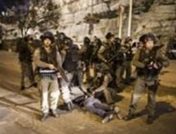
Israeli drones on Sunday afternoon fired a missile at a group of Palestinian youths who were flying fire kites and balloons toward Israeli settlements adjacent to the Gaza Strip.
Local sources said that another airstrike was launched on a Palestinian resistance site east of al-Bureij refugee camp in the central Gaza Strip with no casualties reported.
An Israeli army spokesman said that Israeli drones attacked a group of Palestinians who were preparing fire balloons near the border.
Vast tracts of farmlands in Israeli settlements neighboring the Gaza Strip were damaged by dozens of flaming kites and balloons launched from the coastal enclave.
Hebrew media outlets described the massive fires that broke out in some Israeli settlements on Saturday as the "most violent" since the start of the Great March of Return in late March.
Local sources said that another airstrike was launched on a Palestinian resistance site east of al-Bureij refugee camp in the central Gaza Strip with no casualties reported.
An Israeli army spokesman said that Israeli drones attacked a group of Palestinians who were preparing fire balloons near the border.
Vast tracts of farmlands in Israeli settlements neighboring the Gaza Strip were damaged by dozens of flaming kites and balloons launched from the coastal enclave.
Hebrew media outlets described the massive fires that broke out in some Israeli settlements on Saturday as the "most violent" since the start of the Great March of Return in late March.
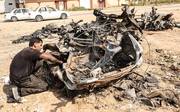
An Israeli military drone fired, on Sunday at dawn, a missile at a Palestinian car which was parked near a mosque, east of Gaza City.
The missile destroyed the car, which was empty at the time of the attack, and caused fire around it, but did not lead to any casualties, media sources in Gaza said.
According to the Israeli army, the targeted car was used by what it called “the leader of a cell that launches incendiary kites and balloons into Israel.”
It added that the strike came in retaliation to “explosive and incendiary balloons and kites, launched from the Gaza Strip” and added that the army “will continue to target, with escalating force, groups responsible for attacks, which endanger the lives of Israelis near the Gaza Strip.”
It held Hamas fully responsible for any escalation and warned that the movement “will suffer the consequences of these attacks.”
On Saturday evening, two Palestinians were injured after an Israeli military drone fired a missile at Palestinians allegedly flying burning kites from central Gaza.
It is worth mentioning that Israeli soldiers have killed 128 Palestinians, and injured approximately 15000 others, since the ” Return March” nonviolent protests started on the Gaza Strip, on Palestinian Land Day on March 30th.
Among the slain Palestinians are two medics, identified as Razan Najjar, 22, and Mousa Jaber Abu Hassanein, 36. The soldiers also injured 223 medics, and caused damage to 37 ambulances.
In addition, the army killed two journalists, identified as Yasser Mortaja, 31, and Ahmad Abu Hussein, 25, and injured 144 others.
The missile destroyed the car, which was empty at the time of the attack, and caused fire around it, but did not lead to any casualties, media sources in Gaza said.
According to the Israeli army, the targeted car was used by what it called “the leader of a cell that launches incendiary kites and balloons into Israel.”
It added that the strike came in retaliation to “explosive and incendiary balloons and kites, launched from the Gaza Strip” and added that the army “will continue to target, with escalating force, groups responsible for attacks, which endanger the lives of Israelis near the Gaza Strip.”
It held Hamas fully responsible for any escalation and warned that the movement “will suffer the consequences of these attacks.”
On Saturday evening, two Palestinians were injured after an Israeli military drone fired a missile at Palestinians allegedly flying burning kites from central Gaza.
It is worth mentioning that Israeli soldiers have killed 128 Palestinians, and injured approximately 15000 others, since the ” Return March” nonviolent protests started on the Gaza Strip, on Palestinian Land Day on March 30th.
Among the slain Palestinians are two medics, identified as Razan Najjar, 22, and Mousa Jaber Abu Hassanein, 36. The soldiers also injured 223 medics, and caused damage to 37 ambulances.
In addition, the army killed two journalists, identified as Yasser Mortaja, 31, and Ahmad Abu Hussein, 25, and injured 144 others.
16 june 2018
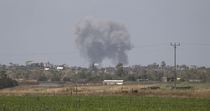
Two Palestinian youths were injured on Saturday evening in an airstrike launched by an Israeli drone near the border fence east of al-Bureij refugee camp in the central Gaza Strip.
The PIC reporter said that an Israeli drone fired at least one missile at a group of Palestinians near the Great March of Return camps injuring two of them.
The Israeli occupation army two days ago said that Israeli drones fired "warning shots" at groups of Palestinian youths trying to fly fire kites and balloons toward Israeli settlements adjacent to the Gaza Strip.
Since the early morning hours, massive fires have erupted in 15 different locations in Israeli settlements in the 1948 occupied Palestinian territories by fire kites and balloons sent from the Gaza Strip.
The Hebrew TV channel 10 reported that nearly 1,000 dunums of farmland have been damaged so far.
The PIC reporter said that an Israeli drone fired at least one missile at a group of Palestinians near the Great March of Return camps injuring two of them.
The Israeli occupation army two days ago said that Israeli drones fired "warning shots" at groups of Palestinian youths trying to fly fire kites and balloons toward Israeli settlements adjacent to the Gaza Strip.
Since the early morning hours, massive fires have erupted in 15 different locations in Israeli settlements in the 1948 occupied Palestinian territories by fire kites and balloons sent from the Gaza Strip.
The Hebrew TV channel 10 reported that nearly 1,000 dunums of farmland have been damaged so far.
15 june 2018
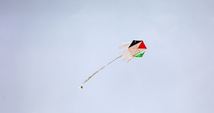
An Israeli drone on Friday fired a missile at a group of fire-kite flyers at the Great March of Return east of al-Bureij refugee camp in the central Gaza Strip.
The PIC reporter said that the airstrike did not result in any casualties, adding that this attack is the third of its kind against Gaza's kite flyers.
In a related context, the PIC reporter said that massive fires erupted in farmlands of Israeli settlements adjacent to the Gaza Strip by flaming kites launched from the enclave.
The Kites Unit of the Great March of Return has vowed to fly thousands of fire-kites toward the Israeli settlements on Friday, while the Israeli army threatened to attack the Palestinian youths responsible for flying the kites following statements by Israel's Prime Minister on Thursday in which he described Gaza's kites as a "nightmare".
The PIC reporter said that the airstrike did not result in any casualties, adding that this attack is the third of its kind against Gaza's kite flyers.
In a related context, the PIC reporter said that massive fires erupted in farmlands of Israeli settlements adjacent to the Gaza Strip by flaming kites launched from the enclave.
The Kites Unit of the Great March of Return has vowed to fly thousands of fire-kites toward the Israeli settlements on Friday, while the Israeli army threatened to attack the Palestinian youths responsible for flying the kites following statements by Israel's Prime Minister on Thursday in which he described Gaza's kites as a "nightmare".
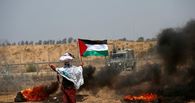
The Israeli occupation forces (IOF) on Friday afternoon opened fire at a Palestinian resistance post east of Rafah city in the southern Gaza Strip with no injuries reported.
The IOF soldiers and snipers were deployed in large numbers along Gaza's eastern border fence in anticipation of major demonstrations scheduled to be launched in Gaza Friday.
The Kites Unit at the Great March of Return has announced that it will fly 5,000 balloons and fire kites on Friday, the first day of Eid al-Fitr, toward Israeli settlements neighboring the Gaza Strip.
The IOF tried to intimidate the Palestinians and prevent them from taking part in Friday's protests. Israeli Helicopters dropped leaflets over the Great March of Return camps warning them against participating in the March and approaching the border fence.
The Israeli settlements have suffered significant losses after vast tracts of their farmlands were damaged by fires caused by Gaza's kites and balloons.
Fire kites are one of the tools used by Palestinian youths in Gaza to respond to the IOF crimes against the peaceful protesters in the Great March of Return.
The IOF soldiers and snipers were deployed in large numbers along Gaza's eastern border fence in anticipation of major demonstrations scheduled to be launched in Gaza Friday.
The Kites Unit at the Great March of Return has announced that it will fly 5,000 balloons and fire kites on Friday, the first day of Eid al-Fitr, toward Israeli settlements neighboring the Gaza Strip.
The IOF tried to intimidate the Palestinians and prevent them from taking part in Friday's protests. Israeli Helicopters dropped leaflets over the Great March of Return camps warning them against participating in the March and approaching the border fence.
The Israeli settlements have suffered significant losses after vast tracts of their farmlands were damaged by fires caused by Gaza's kites and balloons.
Fire kites are one of the tools used by Palestinian youths in Gaza to respond to the IOF crimes against the peaceful protesters in the Great March of Return.
Truce violations List of names Pictures of martyrs
Days: Aug: 26 - 25 - 24 - 23 - 22 - 21 - 20 - 19 - 18 - 17 - 16 - 15 - 14 - 13 - 12 - 11 - 10 - 9 - 8 - 7 - 6 - 5 - 4 - 3 - 2 - 1
July: 31 - 30 - 29 - 28 - 27 - 26 - 25 - 24 - 23 - 22 - 21 - 20 - 19 - 18 - 17 - 16 - 15 - 14 - 13 - 12 - 11 - 10 - 9 - 8
